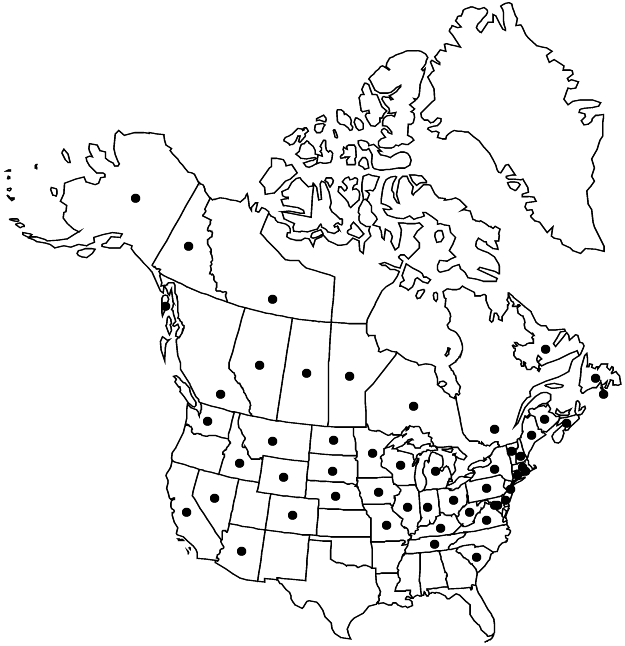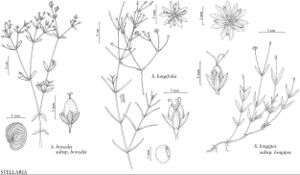Stellaria longifolia
Enum. Pl., 479. 1809.
Plants perennial, forming loose clumps, from elongate rhizomes. Stems erect or straggling, branched, square, 10–35 cm, glabrous but angles minutely papillate-scabrid. Leaves sessile; blade green to yellowish green, never glaucous, linear to very narrowly elliptic, widest at or beyond middle, 0.8–4 cm × 1–3 mm, not coriaceous, base attenuate, apex acuminate to acute, glabrous to sparingly ciliate at base, margins minutely papillate-scabrid; proximal leaves shorter and wider. Inflorescences terminal, widely divaricate, 2–many-flowered cymes; bracts lanceolate, 1–5 mm, scarious, apex acuminate. Pedicels straight or somewhat arcuate, commonly 3–30 mm, glabrous or scabrous. Flowers 5–9 mm diam.; sepals 5, obscurely 3-veined, ovate-elliptic, 2–4 mm, margins scarious, apex acute, glabrous; petals 5, 2–3.5 mm, ± equaling sepals; stamens 5–10; styles 3, ascending, ca. 1 mm. Capsules blackish purple or straw colored, ovoid-conic, 3–6 mm, much longer than sepals, opening by 6 valves; carpophore absent. Seeds brown, broadly reniform, 0.7–0.8 mm diam., slightly rugose. 2n = 26.
Phenology: Flowering late spring–summer.
Habitat: Wet meadows and woodlands, marshes, muskegs, grassy roadsides, usually in circumneutral to calcareous sites
Elevation: 0-2800 m
Distribution

St. Pierre and Miquelon, Alta., B.C., Man., N.B., Nfld. and Labr., N.W.T., N.S., Ont., Que., Sask., Yukon, Alaska, Ariz., Calif., Colo., Conn., Del., D.C., Idaho, Ill., Ind., Iowa, Ky., Maine, Md., Mass., Mich., Minn., Mo., Mont., Nebr., Nev., N.H., N.J., N.Y., N.Dak., Ohio, Pa., R.I., S.C., S.Dak., Tenn., Vt., Va., Wash., W.Va., Wis., Wyo., Europe.
Discussion
Stellaria longifolia often is confused with forms of S. longipes but differs in having leaves that are widest at or above the middle and in having the angles of the stem and/or the leaf margins minutely papillate-scabrid. The capsules can be either straw colored or black. Plants with black capsules have been named var. atrata.
Hybrids with Stellaria borealis subsp. borealis often occur; see note under that species.
Selected References
None.
